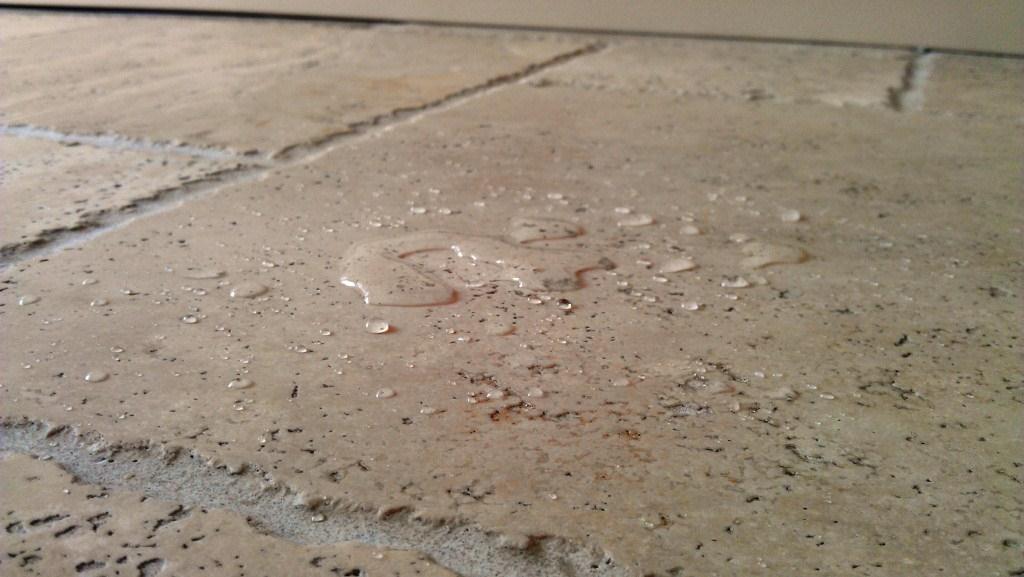This is a big application for CoverTec Products' sealers. Concrete itself is very absorbent, and…
Does Travertine Need to Be Sealed?

Does Travertine Need to Be Sealed?
With its innate charm and distinctive features, Travertine has soared in popularity for indoor and outdoor applications, including flooring, countertops, and decorative accents. Yet, amidst its rising acclaim, a recurring query echoes among homeowners and property managers: Does travertine truly require sealing?
Travertine, a product of mineral deposits from hot springs or limestone caves, boasts intricate patterns and textures, bestowing each piece with a unique identity. This natural stone remains susceptible to water, stains, and environmental elements despite its renowned durability.
Understanding the Crucial Role of Sealing Travertine
Sealing travertine is a pivotal measure in safeguarding its allure and structural integrity. Without this protective layer, travertine becomes vulnerable to moisture infiltration, paving the way for unsightly stains, etching, mold mildew, and potential structural deterioration from salt or chloride attack. Sealing creates a shield on the stone’s surface, thwarting the ingress of liquids, oils, and other detrimental substances into its pores.
The Diverse Landscape of Travertine Sealers
In travertine protection, two distinct classes of sealers reign supreme: topical and penetrating sealers, each offering a nuanced approach to preservation and aesthetic enhancement. Here’s a glimpse into some coveted options:
- StrongSeal Wetlook Concentrate: A heavyweight champion in the sealing arena, this sealer not only furnishes a glossy finish but also enriches travertine’s natural hues and patterns while fortifying it against stains and moisture.
- CoverSeal Pen80: Stealthy yet robust, this penetrating sealer crafts an invisible shield that repels water and moisture, rendering it an ideal choice for safeguarding outdoor travertine against the elements.
- CoverSeal AC250 Matte WB Acrylic Sealer: Embracing subtlety with its low-sheen finish, this sealer bestows a natural aesthetic to travertine while defending against water damage, oil stains, and color degradation.
“The advantage of using a penetrating sealer is that it soaks in the travertine rather than sitting on the surface.” – CoverTec Products
Navigating Between Topical and Penetrating Sealers
While topical sealers like StrongSeal Wetlook and CoverSeal AC250 form a protective film on the surface, enhancing color and acting as a barrier against dirt and stains, penetrating sealers like CoverSeal Pen80 delve deep into the travertine, repelling moisture and contaminants from within. While each approach has its merits, the choice ultimately hinges on desired outcomes and maintenance preferences.
Embracing Eco-Friendly Solutions: The Rise of Water-Based Sealers
Water-based sealers, exemplified by the water-based paver sealer, are gaining traction for their eco-conscious attributes and user-friendly application. Here’s why they’re garnering favor among travertine enthusiasts:
- Environmentally Friendly: With lower VOC emissions, water-based sealers offer a greener alternative to solvent-based counterparts.
- Quick Drying: Their expedited drying times expedite project completion, minimizing downtime.
- Easy Cleanup: Bid farewell to cumbersome cleanup routines, as water-based sealers can be effortlessly rinsed away, catering to the convenience of DIY aficionados.
A Step-by-Step Guide to Sealing Travertine Pavers
- Clean the Surface: Purge the travertine of dirt, debris, and existing sealants using a mild cleanser.
- Allow for Drying Time: Ensure the surface is thoroughly dry to facilitate optimal adhesion of the sealer.
- Select the Right Sealer: Choose a sealer tailored to travertine pavers, aligning with your desired finish and protective requirements.
- Apply the Sealer: A roller or sprayer coats the surface evenly, working in manageable sections to prevent premature drying.
- Allow for Curing Time: Exercise patience as the sealer cures per manufacturer guidelines before subjecting the surface to foot traffic or moisture exposure.
- Inspect and Maintain: Conduct regular inspections to rectify any missed spots or uneven application, committing to a diligent maintenance regimen for enduring beauty.
Mitigating Slip Hazards: A Prudent Approach
While sealing travertine mitigates staining and moisture damage, the specter of slip hazards, particularly in outdoor settings, demands attention. Penetrating sealers maintain surface characteristics, mitigating slipperiness, whereas topical sealers can exacerbate slickness, necessitating the incorporation of anti-slip additives like CoverGrip for enhanced traction.
Conclusion: Preserving the Splendor of Travertine
In essence, sealing travertine pavers emerges as a linchpin in the quest to preserve their allure and longevity. By selecting the appropriate sealer and adhering to meticulous application protocols, you fortify your travertine surfaces against stains, moisture, and environmental adversaries. For personalized guidance or product selection, trust the expertise of CoverTec Products, your partner in travertine preservation.
For further insights into sealing products and maintenance solutions, embark on a journey to CoverTec Products today!
“`
}
</script>

